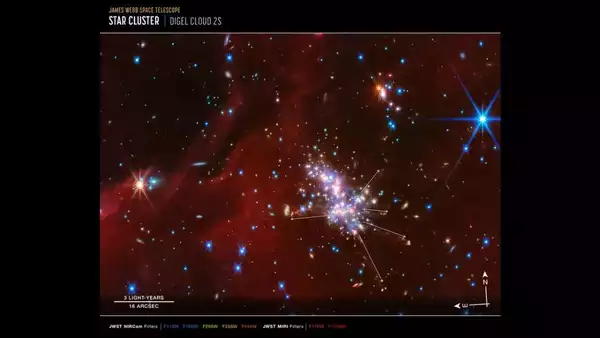The Webb Telescope has taken the exploration of the universe to the next level, by capturing its attention towards the margins of the mysterious Milky Way Galaxy.Today, let’s explore this subject in detail, uncovering intriguing insights into what the telescope has found out.
Unusual observations at the edge of the Galaxy
The newest notations of the James Webb Telescope (JWST) highlighted a unique area, known as the ‘Extreme Outer Galaxy’, which is situated about 58,000 light-years from the center of the Milky Way. For your better understanding and information- – The solar system is approximately 26,000 light-years away from the center of the galaxy, making this review of the galaxy’s outer boundary. The findings have provided an immensely magnificent visual of the clusters of stars going through a significant star formation.
Image credit: NASA, ESA, CSA, STScl, M. Ressler (JPL)
A fresh viewpoint on Star Clusters
A researcher named Natsuko Izumi from Gifu University and the National Astronomical Observatory of Japan, who directed the study, revealed her enthusiasm, stating “The JWST data builds upon what we have incrementally gathered over the years from prior observations with different telescopes and observations. We can get very powerful and impressive images of these clouds with the JWST.”
The Webb Telescope’s Mid-Infrared Camera (MIRI), as well as Near-Infrared Camera (NIRCam), caught specific pictures of two enormous molecular clouds referred to as ‘Digel Cloud 1’ and ‘Digel Cloud 2’. These clouds are, in reality, crowded areas of dust as well as gas, and are the regions where young stars are formed. These mind-blowing images showcased newly formed developing stars that are currently assembling mass and not yet in the stage of initiating fusion reactions.
Protostars and their dynamic expulsions
It has been observed that the protostars are especially active and vigorous, frequently sending out high-intensity streams of extremely hot gas, as they form. This occurrence was vaguely caught in the Telescope pictures. A scientist of NASA’s Jet Propulsion Laboratory, named Mike Ressler noted “What was fascinating and astounding to me from the JWST data is that there are multiple jets shooting out in all different directions from this cluster of stars. It’s a little bit like a firecracker, where you see things shooting this way and that.”
The insights emphasized a particularly active star-forming region that caught attention, referred to as 2S in Digel Cloud 2, uncovering a scenario of immensely dynamic star formation and intense energy emissions.
Unique traits of the Digel Clouds
The Digel Clouds are known to consist of an incredibly unique and surprising arrangement in contrast to the other regions of our Milky Way Galaxy. This composition is comparatively lacking in elements denser than helium as well as hydrogen, commonly known as “metals” by space scientists. This metal-lacking aspect offers highly significant insights and information into the beginning phases of stellar evolution and the characteristics of dwarf galaxies.

Image credit: NASA, ESA, CSA, STScl, M. Ressler (JPL)
Upcoming research directions
The research team is preparing to keep going with the study of these outer regions to achieve an in-depth understanding of the dynamics of star clusters as well as star formation. Their major objective is to find out the reason why stars in these far-off and isolated regions might vary from the more proximate ones to the core of the galaxy.
Izumi shared her persistent interest, mentioning “I’m interested in continuing to study how star formation is occurring in these regions. By combining data from different observatories and telescopes, we can examine each stage in the evolution process.”







